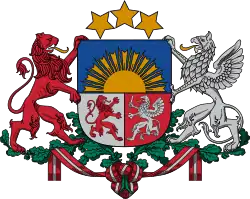1993 Latvian parliamentary election
Parliamentary elections were held in Latvia on 5 and 6 June 1993,[1] the first after independence was restored in 1991. Latvian Way emerged as the largest party in the Saeima, winning 36 of the 100 seats. A total of 23 parties participated in the elections, although only eight received 4% or more of votes and won seats.[2] Voter turnout was 91.2%, the highest in the country's history.[3] Only 66–75% of Latvian residents were citizens and qualified to vote, with the majority of those not able to vote being Russian.[4]
 |
|---|
| This article is part of a series on the politics and government of Latvia |
| Foreign relations |
Results
| Party | Votes | % | Seats |
|---|---|---|---|
| Latvian Way | 362,473 | 32.4 | 36 |
| Latvian National Independence Movement | 149,347 | 13.4 | 15 |
| National Harmony Party | 134,289 | 12.0 | 13 |
| Latvian Farmers' Union | 119,116 | 10.7 | 12 |
| Equal Rights | 64,444 | 5.8 | 7 |
| For Fatherland and Freedom | 59,855 | 5.4 | 6 |
| Christian Democratic Union | 56,057 | 5.0 | 6 |
| Democratic Center Party | 53,303 | 4.8 | 5 |
| Popular Front of Latvia | 29,396 | 2.6 | 0 |
| Green List | 13,362 | 1.2 | 0 |
| Party of Russian Citizens in Latvia | 13,006 | 1.2 | 0 |
| Latvian Democratic Labour Party | 10,509 | 0.9 | 0 |
| Electoral Union "Happiness of Latvia" | 9,814 | 0.9 | 0 |
| Citizens Union "Our Land" | 8,687 | 0.9 | 0 |
| Economic Activity League | 8,333 | 0.7 | 0 |
| Latvian Social Democratic Workers' Party | 7,416 | 0.7 | 0 |
| Anti-Communist Union | 5,954 | 0.5 | 0 |
| Republican Platform | 5,075 | 0.5 | 0 |
| Conservatives and Peasants | 2,797 | 0.3 | 0 |
| Independents' Union | 1,968 | 0.2 | 0 |
| Latvian Liberal Party | 1,520 | 0.1 | 0 |
| Latvian Unity Party | 1,070 | 0.1 | 0 |
| Liberal Alliance | 525 | 0.0 | 0 |
| Invalid/blank votes | 15,888 | – | – |
| Total | 1,134,204 | 100 | 100 |
| Registered voters/turnout | 1,243,956 | 91.2 | – |
| Source: Nohlen & Stöver | |||
Aftermath
A coalition minority government was formed between Latvian Way and the Latvian Farmers' Union. However, the coalition only commanded the support of 48 out of the 100 MPs, meaning that it was heavily reliant on opposition parties to ensure a parliamentary majority.
References
- Dieter Nohlen & Philip Stöver (2010) Elections in Europe: A data handbook, p1122 ISBN 978-3-8329-5609-7
- 5th Saeima Elections CVK
- Nohlen & Stöver, p1123
- "Minorities at Risk Project, Chronology for Russians in Latvia, 2004, Jun 4 - 5, 1993". Center for International Development and Conflict Management (CIDCM), University of Maryland.